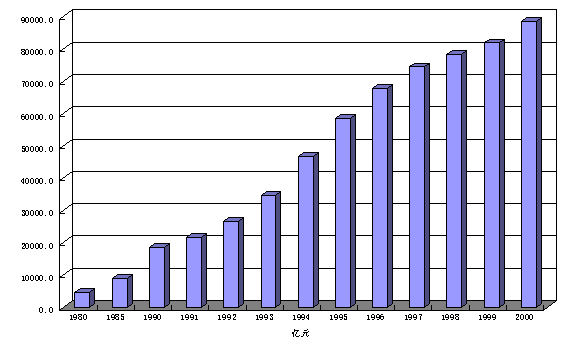Basic Assessment of China’s Economic Development During the 9th Five-Year Plan Period
Aug 16,2001
Hou Yongzhi & Feng Jie
During the 9th Five-Year Plan period, China’s economy maintained a rapid growth, which increased the overall national strength and ensured a better-off life for the people as a whole. In the year 2000, China successfully realized its second-phase strategic goals of the modernization drive. Other targets set for the 9th Five-Year Plan were also smoothly achieved: the economy realized a "soft landing", deflation was brought under control, structural adjustments made progress, and the basis for opening to the outside world was strengthened. The most outstanding problem during the 9th Five-Year Plan period was the aggravating inequality of income distribution, which should attract wide attention.
I. Economic Development Realized the Second-Phase Strategic Targets of the Modernization Drive.
(I) Greater Overall Economic Strength
During the 9th Five-Year Plan period, the Chinese economy continued to maintain a rapid growth. The gross domestic product (GDP) went up by 8.3 percent on an average during the 1995-1999 period and 8 percent in 2000. Although this growth rate was lower than the 9.6 percent for the initial period of reform and opening up (1979-1999) and even lower than the 12 percent during the 8th Five-Year Plan period, it was higher than the growth rates in most countries during the same period. The rapid growth steeply increased the economic aggregates (see chart 1). In 1999, China’s GDP totaled 8,205.4 billion yuan, which was close to 1,000 billion U.S. dollars at the official exchange rate and ranked the seventh in the world in terms of economic strength. In 2000, China’s GDP was expected to reach 8,900 billion yuan, which exceeded the 1,000 billion dollar and a per capita GDP of more than 800 dollars. In comparison with the requirements initially set for the second-phase strategic plan for the modernization drive, China has successfully accomplished the aggregate targets for this period.
(II) Better-off Life for the People
"A better-off life for the people by 2000" was an important content of the second-phase strategic plan for the modernization drive. During the 1995-1999 period, the per capita disposable income of urban families rose from 4,283 yuan to 5,854 yuan and the per capita net income of rural families went up from 1,578 yuan to 2,210 yuan. The income increases of both urban and rural residents boosted their wealth and consumption and improved the structure of consumption.
During the 1995-1999 period, total savings deposits of the urban and rural residents more than doubled, rising from 2,966.0 billion yuan to 5,962.2 billion yuan, with the per capita savings also doubled from 2,356 yuan to 4,735 yuan. At the end of 1999, the total savings of the urban and rural residents were 238 times as much as that by the end of 1980, with the per capita savings rising 118-fold. At the same time, other financial assets of the residents, including foreign exchange deposits, stocks, bonds and cash, also increased drastically.
Chart 1. GDP Growth Since 1980

The consumption of the residents nationwide rose from 803 yuan to 3,143 yuan during the 1995-1999 period. The figure was from 4,874 yuan to 6,750 yuan for the urban residents and 1,434 yuan to 3,168 yuan for the rural residents. During this period, the Engel coefficient1 declined from 49.9 percent to 41.9 percent for the urban residents and from 58.6 percent to 52.6 percent for the rural residents. In comparison with the quantitative standards set in 1992 by the State Statistics Bureau for the definition of a better-off life, our calculation indicates that Chinese residents as a whole are already living a better-off life.














